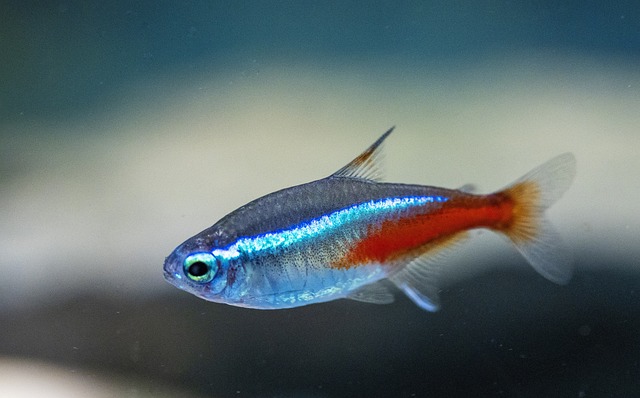Tetras are popular for many aquarium owners due to their vibrant colors and active behavior. However, one question that often arises is whether tetras are livebearers. Livebearers are fish that give birth to live young instead of laying eggs. Some common examples of livebearers include guppies, mollies, and swordtails.
The answer to whether tetras are livebearers is a bit more complicated. While some tetra species, such as the neon tetra, are egg layers, others are livebearers.
One example is the black neon tetra, which gives birth to live young. Therefore, aquarium owners must research the specific species of tetra they plan to keep to determine whether they are egg layers or livebearers.
What Are Tetras?
Tetras are a type of freshwater fish that are popular in the aquarium hobby. They are known for their vibrant colors, peaceful temperament, and ease of care. There are over 150 species of tetras, each with their unique characteristics.
Tetra Species
Some of the most popular tetra species include the neon tetra, cardinal tetra, black skirt tetra, and serpae tetra. Each species has its distinctive coloration and pattern, ranging from bright reds and blues to more muted shades of silver and black.
Tetras come in various sizes, with some species reaching only an inch in length while others can grow up to four inches. They are typically schooling fish, meaning they prefer to live in groups of at least six individuals.
Tetra Characteristics
One of the most notable characteristics of tetras is their peaceful temperament. They are generally non-aggressive and can be kept with other peaceful fish species. Tetras are also relatively easy to care for, requiring a basic aquarium setup with a filter, heater, and appropriate water parameters.
Tetras are omnivores and eat various foods, including flakes, pellets, and live or frozen foods. In addition, they are active swimmers and will appreciate a well-planted aquarium with plenty of hiding places.
In summary, tetras are a diverse group of freshwater fish that are popular in the aquarium hobby. They are known for their vibrant colors, peaceful temperament, and ease of care. With over 150 species, there is a tetra for every aquarium setup.
Livebearers vs. Egg-layers
Livebearer Species
Livebearers are fish that give birth to live young instead of laying eggs. They are popular among aquarium hobbyists due to their colorful appearance and ease of care. Some common livebearer species include:
- Guppies
- Mollies
- Platies
- Swordtails
Livebearers are known for their prolific breeding habits, with females capable of producing dozens of fry at a time. They are also relatively easy to breed, making them popular for beginner breeders.
Egg-layer Species
Egg-layers, on the other hand, are fish that lay eggs instead of giving birth to live young. They are generally less prolific breeders than livebearers but can still produce many eggs simultaneously. Some common egg-layer species include:
- Bettas
- Tetras
- Angelfish
- Gouramis
Egg-layers require more specific breeding conditions than livebearers, as their eggs must be carefully fertilized and incubated. They are, therefore, generally less popular among beginner breeders.
In conclusion, livebearers and egg-layers are two distinct types of fish with different breeding habits and care requirements. While livebearers are known for their ease of care and prolific breeding, egg-layers require more specific breeding conditions and are generally less popular among beginner breeders.
Are Tetras Livebearers?
Tetras are a diverse family of freshwater fish known for their bright colors, active behavior, and popularity in the aquarium hobby. One of the questions that often comes up is whether tetras are livebearers or egg-layers. The answer is that it depends on the species.
Livebearing Tetra Species
Some tetra species are livebearers, meaning they give birth to live young instead of laying eggs. Livebearing tetras are part of the Poeciliidae family, including guppies, mollies, and swordtails.
The Black Neon Tetra (Hyphessobrycon herbertaxelrodi) is the most common livebearing tetra native to the Amazon Basin in South America. Other livebearing tetras include the Redtail Splitfin (Xenotoca eiseni) and the Green Swordtail (Xiphophorus helleri).
Livebearing tetras are easy to breed and care for, making them popular for beginner aquarists. They are also known for their peaceful temperament and ability to coexist with other fish species.
Egg-laying Tetra Species
The majority of tetra species are egg-layers, which means that they lay eggs that hatch into fry. Egg-laying tetras are part of the Characidae family, which includes many popular aquarium fish such as Neon Tetras (Paracheirodon innesi), Cardinal Tetras (Paracheirodon axelrodi), and Serpae Tetras (Hyphessobrycon eques).
Egg-laying tetras require specific water parameters and conditions to breed successfully. They need soft, acidic water with plenty of plants and hiding spots for the fry.
Some egg-laying tetras are more challenging to breed than others, but raising healthy fry with the proper setup and care is possible.
In conclusion, while not all tetras are livebearers, some species are. Therefore, it is essential to research each species’ specific requirements and behaviors before adding them to an aquarium.
Conclusion
In conclusion, while some tetra species are livebearers, most tetras lay eggs. Therefore, it is essential to research the specific species of tetra you are interested in keeping to determine whether they are livebearers or egg-layers.
Aquarium hobbyists often prefer livebearing tetras, such as the black neon tetra and the red phantom tetra, because they can be easier to breed and raise. However, it is essential to note that live-bearing fish can also be more aggressive toward their offspring, so proper care and breeding techniques should be researched and implemented.
Whether a tetra is a livebearer or an egg layer should not be the only factor considered when deciding which species to keep in an aquarium. Other factors, such as water parameters, tank size, and compatibility with other fish, should also be considered. However, with proper research and care, livebearing and egg-laying tetras can significantly add to a community aquarium.




